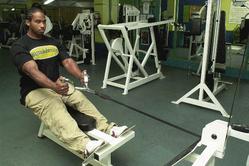
Kenneth Gardner
Dear Mr. Gardner, I am a regular reader of your articles published in the Gleaner. What are the best exercises for a sciatic nerve injury?
Dear Reader,
Sciatica is a general term that refers to pain or discomfort caused by compression or irritation of the sciatic nerve and is typically felt in the rear, down the back of the leg and possibly to the foot.
Sciatica is actually a symptom rather than a diagnosis. This means that a person is experiencing pain or discomfort down the leg from compression on the sciatic nerve. The diagnosis refers to what is actually causing the compression, for example a degenerative disc disease.
The sciatic nerve is the largest and longest nerve in the body. It is about the thickness of a person's thumb. The nerve originates in the lower part of the spinal cord then branches off from the spinal cord as it passes between the bony vertebrae and runs through the hip bones. It connects the spinal cord with the muscles of the hamstring, thighs and those in the lower legs and feet. When the nerve is impaired it may lead to muscle weakness in the leg and/or tingling or numbness.
Exercise is essential
Active exercise is essential to sciatic pain relief. Without exercise the muscles and spinal structures will become de-conditioned and less able to support the back. De-conditioning and weakening can lead to back injury and strain which may worsen the condition.
Sciatic exercises should focus on strengthening the back and abdominal muscles in order to provide support for the back. Stretching exercises are also recommended for muscles that are painful when they are tight and inflexible.
Persons who engage in regular programmes of strengthening and stretching exercises normally recover more quickly from a flare up of sciatica. In addition to an exercise programme, persons with sciatic nerve injury should reduce everyday stress on the lower back, use good ergonomics while lifting objects, maintain good posture and avoid standing for long periods of time.
Here is a list of exercises to strengthen your abdominal and back muscles.

Exercise instructor, Damion Christian, demonstrates an exercise to strengthen the back at Gymkhana at the Hilton Kingston hotel. - Ricardo Makyn/Staff Photographer
Seated pulley rows (back exercise)
Grasp handles and place feet against the stop bar.
Sit down with legs slightly bent and arms straighten.
Slowly pull the handles towards your lower ribcage with elbows in close to your sides.
Slowly reverse movement and return to starting point.
Leg raise (abdominal exercise)
Lie on your back on an inclined board with your head towards the raised ends.
Grasp the ends of the upper bench with your hands to stabilise your body.
Use your abdominal muscles to raise your feet in an arc directly above your head.
Lower feet slowly and repeat movement.
Shoulder shrug (back exercise)
Start with a barbell hanging at arms length in front of your body.
Hold the bar with both hands in a pronated (thumb in) grip.
Inhale as you lift or shrug your shoulders to the highest possible position.
Exhale as you slowly lower the bar to the starting position.
Cubex abdominal machine (abdominal exercise)
Start in a seated position with your feet under the anchor straps and your upper chest against the padded exercise bar.
Exhale as you pull with your abdominal muscles to curl your chest towards your hips.
Inhale as you slowly allow your chest to return to the starting position.
Kenneth Gardner is an exercise physiologist at the G.C. Foster College of Physical Education: email: yourhealth@gleanerjm.com.
